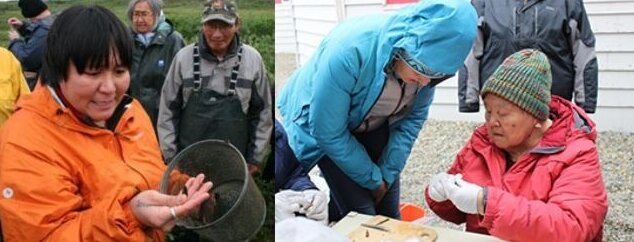
2023
What’s new
Sivuqaq’s Community-Driven Science: Documenting Contamination in the Arctic
Due to a combination of global distillation processes and military contamination, the Yupik people of Sivuqaq (the traditional name for St. Lawrence Island) experience disproportionately high exposure to persistent organic pollutants (POPs) and other chemicals — resulting in dramatic health disparities.
A recent webinar hosted by CHE Alaska highlighted the Alaska Community Action on Toxics’ (ACAT’s) ongoing Community-Based Participatory Research with the Sivuqaq community to document these exposures and health outcomes. The discussion featured speakers Viola “Vi” Waghiyi, Dr. Sam Byrne, and Sandra Gologergen.
Impacts of pollutants on Indigenous communities
As a community whose way of life is deeply intertwined with the land and the ocean, the people of Sivuqaq are particularly vulnerable to environmental pollution. Vi Waghiyi, ACAT’s Environmental Health and Justice Program Director, described some of the sources of pollutants, and their effects on the Yupik people.
The Northeast Cape of Sivuqaq, for example, is subject to contamination from two abandoned Cold War-era military bases which displaced a tribal community — and left behind PCBs, pesticides, heavy metals, and solvents. Initial biomonitoring and blood sampling found that Sivuqaq residents had four to ten times higher PCBs than the average American in the contiguous US.
Waghiyi says the Northeast Cape Silky River used to have one of the most abundant fishing grounds on our island. “Due to massive fuel spills and contamination, the fish have never returned. We have no more seal haulouts .. and we now have a cancer crisis.”
In addition to higher rates of cancer, the community has unusually high rates of thyroid disease, diabetes, heart disease, developmental disabilities, birth defects, and reproductive problems. These ailments are occurring at rates “never seen before in our people,” says Waghiyi. “In the 1950s we had one case of cancer. Now, it's not a matter of if we'll get cancer, but when.”
The Yupik people’s reliance on traditional subsistence foods, particularly sea mammals which have high levels of polychlorinated biphenyls (PCBs), increases the risk of exposure. Dr. Byrne explains, “PCBs bioaccumulate in living things and biomagnify up the food chain…the higher up the food chain a species is, the more likely it is to be contaminated.”
The Arctic is also a hemispheric sink for pollutants, condensing and trapping compounds evaporated from lower latitudes. The exceedingly high levels of PCBs found in the Northeastern Cape people can also be linked to the military site, which Byrne notes is an ongoing source of contamination.
Scientists follow community’s lead
Dr. Sam Byrne, an environmental epidemiologist at Middlebury College, discussed the research design and findings in more depth. After asking community members to outline their concerns, researchers decided to conduct both an epidemiological study and an ecotoxicological study.
With the help of Sivuqaq community members in designing and conducting the sampling process, the team studied PFAS exposure, and found that PFAS are present in both residents and the local environment. Sources included both local diet and indoor environment/personal product use.
To get a sense of Sivuqaq’s broader ecological contamination, they studied the ninespine stickleback as a sentinel species, as well as examining traditional food samples such as bowhead whale, reindeer, and seal.
The group also tested PCB concentrations in Dolly Varden trout, a typical food source for residents, near the military site. Almost all the fish had PCB levels exceeding the EPA-recommended consumption limit of three servings per month. Byrne noted that community members made it clear that for ongoing and future work, protecting the next generations from the impacts of pollution was a priority.
Community empowerment, traditional knowledge
Savoonga tribal citizen and Community Work Group Mentor Sandra Gologergen closed the webinar by sharing her experiences with the program, and a community perspective on the research.
Waghiyi emphasized the importance of academic partnerships in which Indigenous people’s knowledge, or Traditional Ecological Knowledge, is valued and respected on par with Western science. “It's so important that we are not only research subjects, but that we help design this research -- that we are the ones to come up with questions about how these toxic chemicals may be affecting our lands and waters and bodies.”
Visit the webinar page to watch the full recording and find out more about this important research.
This organizational blog was produced by CHE's Science Communications Intern, Sarah Banapour.


